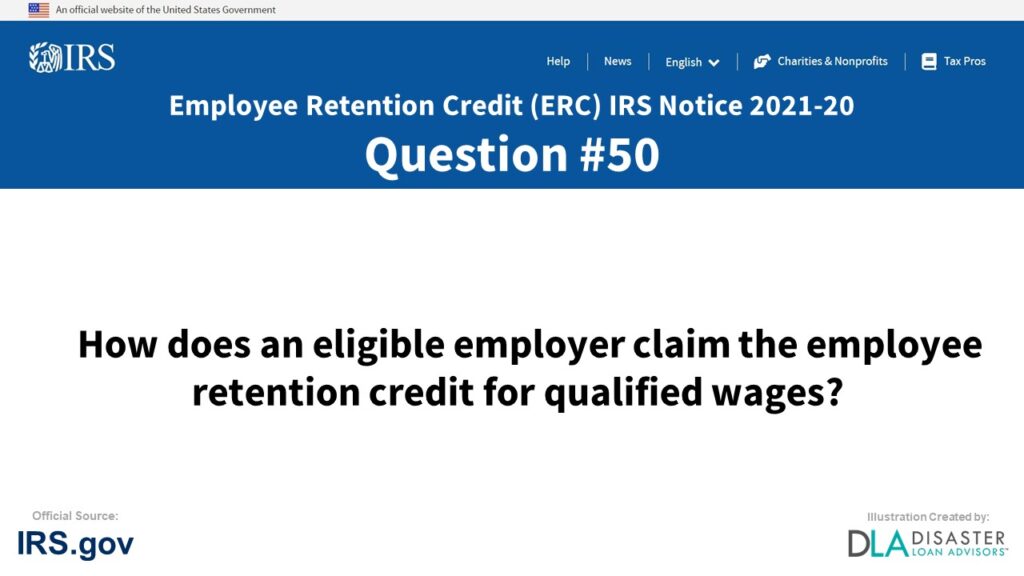
Question #50:
How does an eligible employer claim the employee retention credit for qualified wages?
Found under the J. Claiming the Employee Retention Credit section of the Employee Retention Credit (ERC) IRS Notice 2021-20 with updated guidance to help business owners follow the current ERC rules.
The answer to question #50, How does an eligible employer claim the employee retention credit for qualified wages?, can be found below.
ERC IRS Notice 2021-20 Question #50:
J. Claiming the Employee Retention Credit
How does an eligible employer claim the employee retention credit for qualified wages?
An eligible employer claims the employee retention credit for qualified wages by reporting its qualified wages and the amount of the credit to which it is entitled on the designated lines of its federal employment tax return(s). Employers also report any qualified sick leave wages and qualified family leave wages and claim the credit under sections 7001 or 7003 of the FFCRA on the designated lines on their federal employment tax returns. For most employers, Form 941 is used to report income and social security and Medicare taxes withheld by the employer from employee wages, as well as the employer’s share of social security and Medicare tax.
In anticipation of receiving the employee retention credit, eligible employers can (1) reduce their deposits of federal employment taxes, including withheld taxes, that would otherwise be required up to the amount of the anticipated credit, and (2) request an advance of the amount of the anticipated credit that exceeds the reduced federal employment tax deposits by filing Form 7200.
Example: Employer A paid $10,000 in qualified wages (including allocable qualified health plan expenses), among other wages. After deferral of the employer’s share of social security tax under section 2302 of the CARES Act, Employer A is otherwise required to deposit $8,000 in federal employment taxes for all of its employees for all wage payments made during the same quarter as the $10,000 in qualified wages. Employer A did not choose to use the relief under Notice 2020-65 to defer the employee’s share of social security tax. Employer A has no credits under sections 7001 and 7003 of the FFCRA. Employer A is not a tax-exempt organization eligible for the credit under section 303(d) of the Relief Act. In anticipation of the employee retention credit, Employer A may keep up to $5,000 of the $8,000 of taxes Employer A was otherwise required to deposit, and it will not owe a failure to deposit penalty for keeping the $5,000. Employer A will later account for the $5,000 it retained when it files Form 941 for the quarter.
For more information about the Employee Retention Credit (ERC) IRS Notice 2021-20, visit the Internal Revenue Service (IRS) Department of the Treasury, official IRS.gov tax website.
Conclusion and Summary on How does an eligible employer claim the employee retention credit for qualified wages? – #50 ERC IRS Notice 2021-20
The answer to Question #50: “How does an eligible employer claim the employee retention credit for qualified wages?” was answered in detail above. It was found under section “J. Claiming the Employee Retention Credit” in IRS Notice 2021-20.
Leave a comment below if you have further questions on the Employee Retention Credit (ERC) or for clarifications on How does an eligible employer claim the employee retention credit for qualified wages?
Employee Retention Tax Credit (ERTC): Expert Assistance to Claim Your Business ERC Credit
Up to a $26,000 ERC Refund from the IRS for Each Employee
Disaster Loan Advisors can assist your business with the complex and confusing Employee Retention Credit (ERC), Form 941-X, and the Employee Retention Tax Credit (ERTC) program.
Depending on eligibility, business owners and companies can receive up to $26,000 per employee based on the number of W2 employees you had on the payroll in 2020 and 2021.
The ERC / ERTC Tax Credit Program is a valuable IRS tax credit you can claim. This is money you have already paid to the IRS in payroll taxes for your W2 employees.
We DO NOT charge a percentage (%) of your ERC Refund like some companies are charging. Some ERC firms out there are charging upwards of 15% to 35% of your ERC refund!
Our professional ERC fee and pricing structure is very reasonable in comparison.
If you are looking for an ERC Company that believes in providing professional ERC Services and value, in exchange for a fair, reasonable, and ethical fee for the amount of work required, Disaster Loan Advisors is a good fit for you.
Schedule Your Free Employee Retention Credit Consultation to see what amount of employee retention tax credit your company qualifies for.
Cover Image Credit: Irs.gov / IRS Notice 2021-20 / Disaster Loan Advisors.
